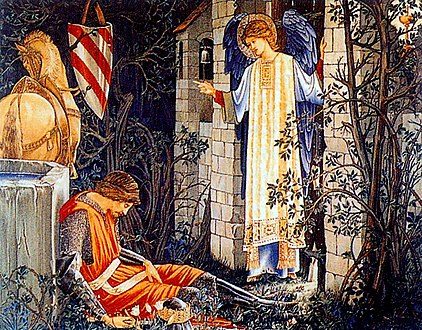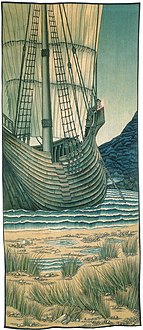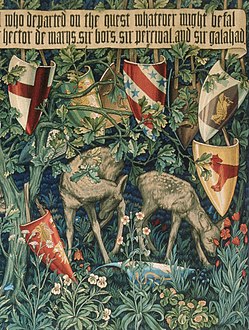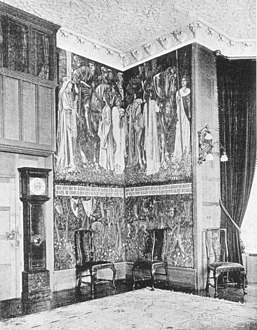
The Holy Grail is a treasure that serves as an important motif in Arthurian literature. Various traditions describe the Holy Grail as a cup, dish, or stone with miraculous healing powers, sometimes providing eternal youth or sustenance in infinite abundance, often guarded in the custody of the Fisher King and located in the hidden Grail castle. By analogy, any elusive object or goal of great significance may be perceived as a "holy grail" by those seeking such.

Lancelot du Lac, alternatively written as Launcelot and other variants, is a popular character in Arthurian legend's chivalric romance tradition. He is typically depicted as King Arthur's close companion and one of the greatest Knights of the Round Table, as well as a secret lover of Arthur's wife, Guinevere.
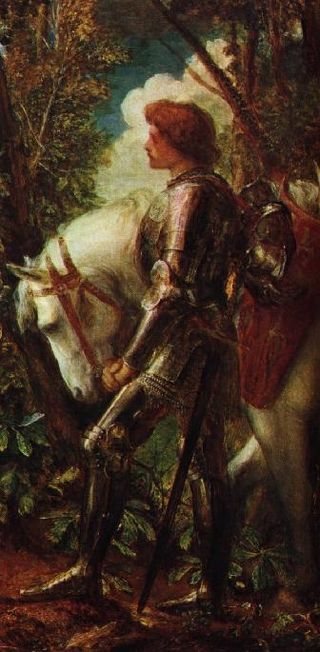
Galahad, sometimes referred to as Galeas or Galath, among other versions of his name, is a knight of King Arthur's Round Table and one of the three achievers of the Holy Grail in Arthurian legend. He is the illegitimate son of Sir Lancelot du Lac and Lady Elaine of Corbenic and is renowned for his gallantry and purity as the most perfect of all knights. Emerging quite late in the medieval Arthurian tradition, Sir Galahad first appears in the Lancelot–Grail cycle, and his story is taken up in later works, such as the Post-Vulgate Cycle, and Sir Thomas Malory's Le Morte d'Arthur. In Arthurian literature, he replaced Percival as the hero in the quest for the Holy Grail.

Sir Edward Coley Burne-Jones, 1st Baronet, was an English painter and designer associated with the Pre-Raphaelite Brotherhood's style and subject matter.

The Knights of the Round Table are the legendary knights of the fellowship of King Arthur that first appeared in the Matter of Britain literature in the mid-12th century. The Knights are an order dedicated to ensuring the peace of Arthur's kingdom following an early warring period, entrusted in later years to undergo a mystical quest for the Holy Grail. The Round Table at which they meet is a symbol of the equality of its members, who range from sovereign royals to minor nobles.

Percival, alternatively called Peredur, is a figure in the legend of King Arthur, often appearing as one of the Knights of the Round Table. First mentioned by the French author Chrétien de Troyes in the tale Perceval, the Story of the Grail, he is best known for being the original hero in the quest for the Grail before being replaced in later literature by Galahad.
Percival's sister is a role of two similar but distinct characters in the Holy Grail stories within the Arthurian legend featuring the Grail hero Percival (Perceval). The first of them is named Dindrane, the second is usually unnamed and is known today as the Grail heroine.

The Fisher King is a figure in Arthurian legend, the last in a long line of British kings tasked with guarding the Holy Grail. The Fisher King is both the protector and physical embodiment of his lands, but a wound renders him impotent and his kingdom barren. Unable to walk or ride a horse, he is sometimes depicted as spending his time fishing while he awaits a "chosen one" who can heal him. Versions of the story vary widely, but the Fisher King is typically depicted as being wounded in the groin, legs, or thigh. The healing of these wounds always depends upon the completion of a hero-knight's task.

In Arthurian legend, the Siege Perilous is a vacant seat at the Round Table reserved by Merlin for the knight who would one day be successful in the quest for the Holy Grail.

Conquests of Camelot: The Search for the Grail is a graphic adventure game released in 1990 by Sierra On-Line. It was the first game in the Conquests series designed by Christy Marx and her husband Peter Ledger. The only other game in the series was 1991's Conquests of the Longbow: The Legend of Robin Hood. Marx did the majority of the design work while Ledger created the game and package art.

The Lancelot-Grail Cycle, also known as the Vulgate Cycle or the Pseudo-Map Cycle, is an early 13th-century French Arthurian literary cycle consisting of interconnected prose episodes of chivalric romance originally written in Old French. The work of unknown authorship, presenting itself as a chronicle of actual events, retells the legend of King Arthur by focusing on the love affair between Lancelot and Guinevere, the religious quest for the Holy Grail, and the life of Merlin. The highly influential cycle expands on Robert de Boron's "Little Grail Cycle" and the works of Chrétien de Troyes, previously unrelated to each other, by supplementing them with additional details and side stories, as well as lengthy continuations, while tying the entire narrative together into a coherent single tale. Its alternate titles include Philippe Walter's 21st-century edition Le Livre du Graal.

Morris, Marshall, Faulkner & Co. (1861–1875) was a furnishings and decorative arts manufacturer and retailer founded by the artist and designer William Morris with friends from the Pre-Raphaelites. With its successor Morris & Co. (1875–1940) the firm's medieval-inspired aesthetic and respect for hand-craftsmanship and traditional textile arts had a profound influence on the decoration of churches and houses into the early 20th century.
Perlesvaus, also called Li Hauz Livres du Graal, is an Old French Arthurian romance dating to the first decade of the 13th century. It purports to be a continuation of Chrétien de Troyes' unfinished Perceval, the Story of the Grail, but it has been called the least canonical Arthurian tale because of its striking differences from other versions.
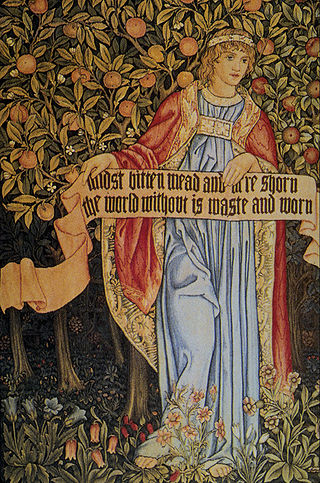
John Henry Dearle was a British textile and stained-glass designer trained by the artist and craftsman William Morris who was much influenced by the Pre-Raphaelite Brotherhood. Dearle designed many of the later wallpapers and textiles released by Morris & Co., and contributed background and foliage patterns to tapestry designs featuring figures by Edward Burne-Jones and others. Beginning in his teens as a shop assistant and then design apprentice, Dearle rose to become Morris & Co.'s chief designer by 1890, creating designs for tapestries, embroidery, wallpapers, woven and printed textiles, stained glass, and carpets. Following Morris's death in 1896, Dearle was appointed Art Director of the firm, and became its principal stained glass designer on the death of Burne-Jones in 1898.

The New Gallery is a Crown Estate-owned Grade II Listed building at 121 Regent Street, London, which originally was an art gallery from 1888 to 1910, The New Gallery Restaurant from 1910 to 1913, The New Gallery Cinema from 1913 to 1953, and a Seventh-day Adventist Church from 1953 to 1992. After having been empty for more than ten years, the building was a Habitat furniture store from 2006 to 2011, and since September 2012 it is a flagship store for Burberry.

The Star of Bethlehem is a painting in watercolour by Sir Edward Burne-Jones depicting the Adoration of the Magi with an angel holding the star of Bethlehem. It was commissioned by the Corporation of the City of Birmingham for its new Museum and Art Gallery in 1887, two years after Burne-Jones was elected Honorary President of the Royal Birmingham Society of Artists. At 101 ⅛ × 152 inches, The Star of Bethlehem was the largest watercolour of the 19th century. It was completed in 1890 and was first exhibited in 1891.

The Adoration of the Magi is a Morris & Co. tapestry depicting the story in Christianity of the Three Kings who were guided to the birthplace of Jesus by the star of Bethlehem. It is sometimes called The Star of Bethlehem or simply The Adoration.
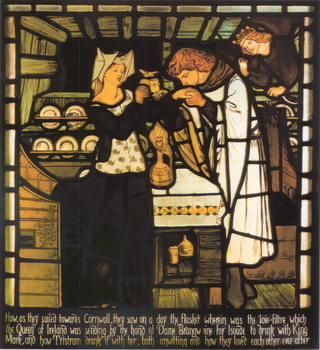
The Tristram and Isoude stained glass panels are a series of 13 small stained-glass windows made in 1862 by Morris, Marshall, Faulker & Co. for Harden Grange, the house of textile merchant Walter Dunlop, near Bingley in Yorkshire, England. Depicting the legend of Tristan and Iseult, they were designed by six of the leading Pre-Raphaelite artists of the day, to an overall design by William Morris. They were acquired in 1917 by Cartwright Hall Art Gallery, which is now part of Bradford Museums & Galleries. They can be seen on display at Cliffe Castle, Keighley.

William Morris (1834-1898), a founder of the British Arts and Crafts movement, sought to restore the prestige and methods of hand-made crafts, including textiles, in opposition to the 19th century tendency toward factory-produced textiles. With this goal in mind, he created his own workshop and designed dozens of patterns for hand-produced woven and printed cloth, upholstery, and other textiles.

The Lady of Shalott is an oil painting by the English artist William Holman Hunt, made c. 1888–1905, and depicting a scene from Tennyson's 1833 poem, "The Lady of Shalott". The painting is held by the Wadsworth Atheneum, in Hartford, Connecticut. A smaller version is held by the Manchester Art Gallery.


